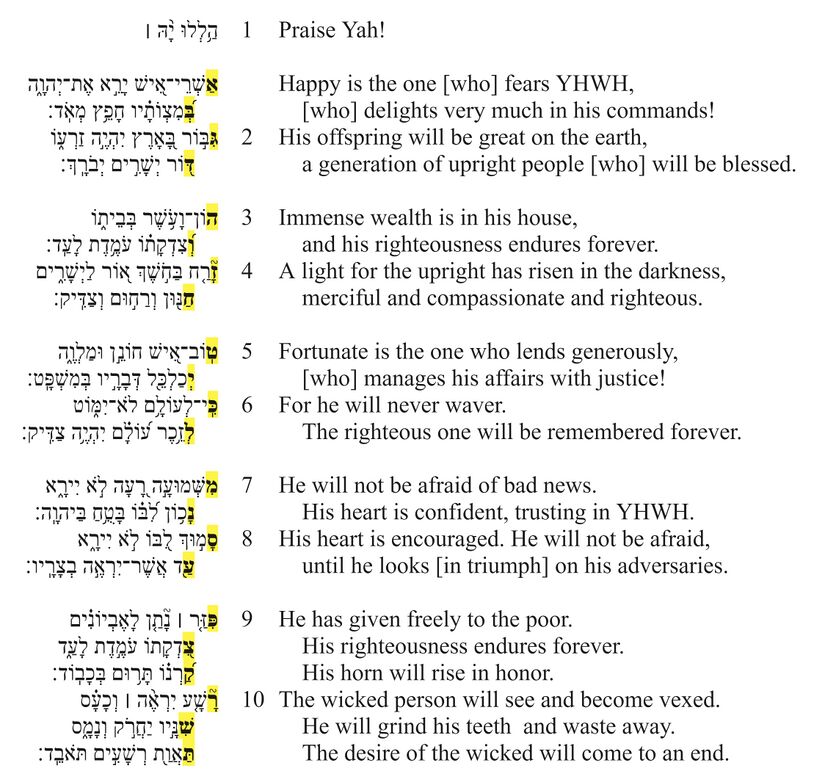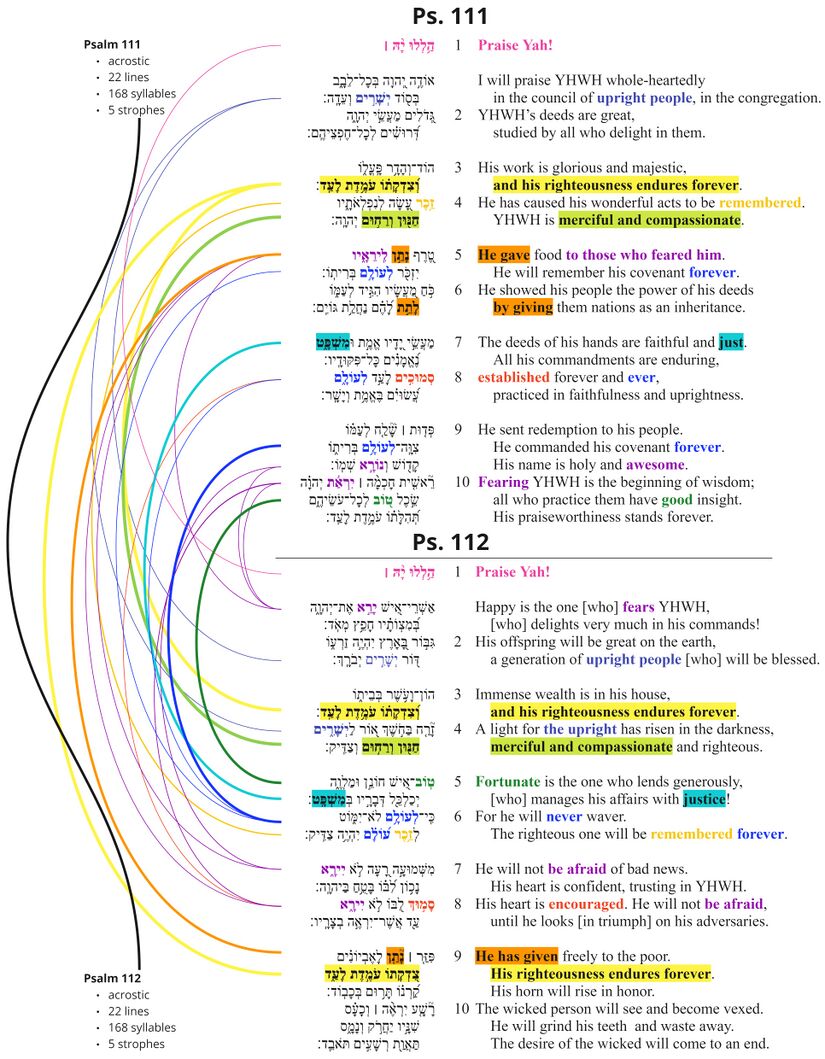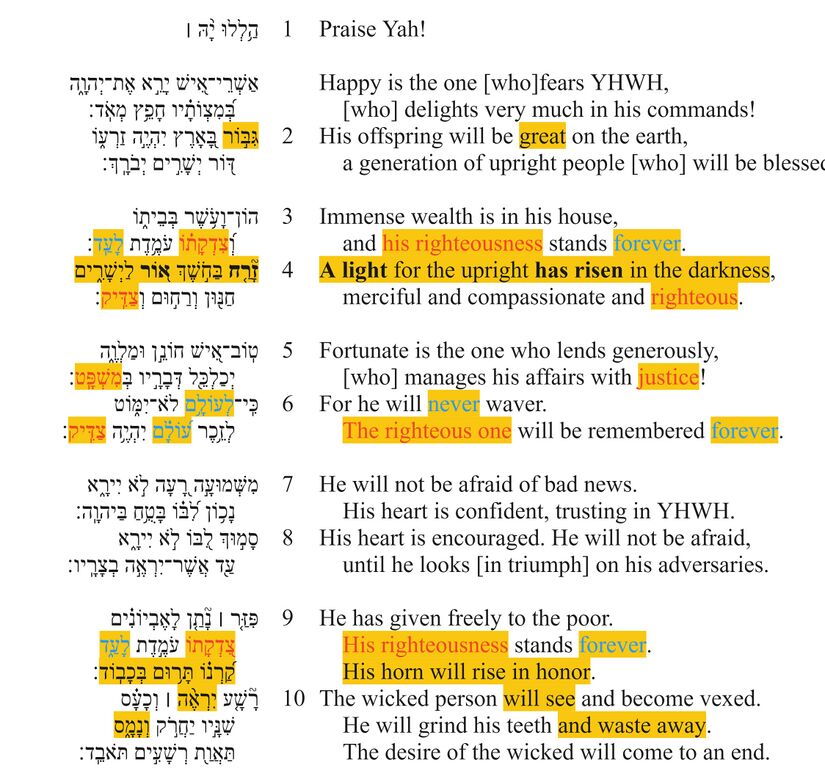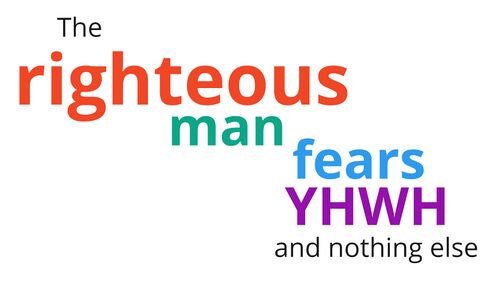Psalm 112 Poetic Features
Poetic Features
In poetic features, we identify and describe the “Top 3 Poetic Features” for each Psalm. Poetic features might include intricate patterns (e.g., chiasms), long range correspondences across the psalm, evocative uses of imagery, sound-plays, allusions to other parts of the Bible, and various other features or combinations of features. For each poetic feature, we describe both the formal aspects of the feature and the poetic effect of the feature. We assume that there is no one-to-one correspondence between a feature’s formal aspects and its effect, and that similar forms might have very different effects depending on their contexts. The effect of a poetic feature is best determined (subjectively) by a thoughtful examination of the feature against the background of the psalm’s overall message and purpose.
A to Z Celebration
If an emendation or revocalization is preferred, that emendation or revocalization will be marked in the Hebrew text of all the visuals.
| Emendations/Revocalizations legend | |
|---|---|
| *Emended text* | Emended text, text in which the consonants differ from the consonants of the Masoretic text, is indicated by blue asterisks on either side of the emendation. |
| *Revocalized text* | Revocalized text, text in which only the vowels differ from the vowels of the Masoretic text, is indicated by purple asterisks on either side of the revocalization. |
Feature
Psalm 112 is an acrostic poem, in which each line begins with a successive letter of the Hebrew alphabet (cf. Ps. 111).
Effect
The alphabet is a symbol of completeness.[1] In an acrostic poem, the poet takes a topic (e.g., Torah [Ps. 119], or the virtuous woman [Prov. 31]) and expounds on it completely (from every possible angle), so that the reader walks away with a high-resolution image of the topic (i.e., he/she understands it “from A to Z”). In Psalm 112, the topic is "the man who fears YHWH" (v. 1a).
The Imitation of God
If an emendation or revocalization is preferred, that emendation or revocalization will be marked in the Hebrew text of all the visuals.
| Emendations/Revocalizations legend | |
|---|---|
| *Emended text* | Emended text, text in which the consonants differ from the consonants of the Masoretic text, is indicated by blue asterisks on either side of the emendation. |
| *Revocalized text* | Revocalized text, text in which only the vowels differ from the vowels of the Masoretic text, is indicated by purple asterisks on either side of the revocalization. |
Feature
Psalm 112 is so closely related to Psalm 111 that some have argued that Psalm 112 is actually based on Psalm 111[2] and/or that the two psalms might be the work of the same author (cf. Calvin).
In terms of structure, the two psalms are nearly identical. Each psalm is an acrostic in which each line begins with a successive letter of the Hebrew alphabet. Thus, each psalm has 22 lines (8 bicola and 2 tricola). Furthermore, in each psalm these lines are arranged into 5 strophes. Fokkelman has argued that the two psalms even have the same number of syllables: 168.[3] Both psalms also have identical superscriptions.
In addition to these similarities, there are a number of linguistic (mostly lexical) connections between the two psalms (shown with colored text and connecting lines).
In several of these connections, what is said of YHWH in Ps. 111 is said of the man in Ps. 112 (see highlighted text and thick connecting lines).
Other language used to describe the man in Ps. 112 is elsewhere applied only to YHWH (e.g., solar imagery in v. 4 [cf. Deut. 33:2]; see poetic feature #3).
Effect
The man in Psalm 112 is described in terms that are especially (and, in some cases, uniquely) appropriate to YHWH. Like YHWH, the man "gives" generously (111:5//112:9) and carries out his work in "justice" (111:7//112:5). Like YHWH, he is "merciful and compassionate" (111:4//112:4), and "his righteousness stands forever" (111:3//112:3, 9).
In other words, the person who fears YHWH and follows his commands becomes like YHWH in terms of his character.
This parallel description of YHWH and the man is perhaps more understandable (though still striking) if the man in Psalm 112 is a king (see exegetical issue). In Israel, as in the wider ANE, the king was both the image of God and the son of God (cf. Ps. 2), and, as such, he was expected to resemble the character of his God.
The conflation or blurring of YHWH and the king occurs elsewhere in the psalms (e.g., Pss. 2; 45; 110). It is perhaps significant that the pair Pss. 111–112 follows Ps. 110, in which it is difficult to distinguish the king's activity from YHWH's activity (see poetic feature for Ps. 110).
Like the Sun
If an emendation or revocalization is preferred, that emendation or revocalization will be marked in the Hebrew text of all the visuals.
| Emendations/Revocalizations legend | |
|---|---|
| *Emended text* | Emended text, text in which the consonants differ from the consonants of the Masoretic text, is indicated by blue asterisks on either side of the emendation. |
| *Revocalized text* | Revocalized text, text in which only the vowels differ from the vowels of the Masoretic text, is indicated by purple asterisks on either side of the revocalization. |
Feature
In v. 4, the man who fears YHWH is described as "a light" which has "risen (זרח) in the darkness." The subject of the verb זרח (in the sense of "dawn") is almost always the sun (Gen. 32:32; Ex. 22:2; 2 Sam. 34:4; 1 Kgs. 3:22; Jon. 4:8; Nah. 3:17; Ps. 104:22; Eccl. 1:5). Thus, in v. 4 the man is compared to the sun.
Solar imagery is not limited to v. 4, however. Other parts of the psalm play on this solar imagery, especially vv. 9–10, which mentions a horn rising (v. 9c), the wicked seeing (v. 10a), and the wicked melting (v. 10c). Horns in the OT are sometimes "a symbol for radiance" (DBI, "Horns" cf. Hab. 3:4; Ps. 132:17; cf. the fact that, according to Ges-18 and HALOT, in Arabic, qrn can refer to the "first visible part of the rising sun"). The word "glory" (v. 9c) is also associated with the sun (cf. Isa. 60:1–2; Ezek. 43:2). "Seeing" (v. 10a) is, obviously, associated with the sun (cf. Egyptian Hymn to the Sun God in COS 1.27 — "through you do all eyes see"). The word translated "waste away" (lit.: "melt", Heb.: מסס) is something which the sun causes to happen (cf. Ex. 16:21).
Solar imagery is also related to the most-repeated root in this psalm: the root צדק (vv. 3b, 4b, 6b, 9b; cf. the related noun משפט in v. 5b). The attribute of righteousness (צדקה) is often associated with the sun (Mal. 3:20 [שמש צדקה]; Pss. 5; 19; 1Q27 I:6–7 [=1 Myst] והצדק יגלה כשמש; cf. the Mesopotamian sun god Shamash, the god of justice).
Solar imagery might also be related to the 'forever' language in the psalm (vv. 3b, 6ab, 9b). In Ps. 89, for example, the king's dynasty is compared to the sun in the sense that it lasts "forever"—זַ֭רְעוֹ לְעוֹלָ֣ם יִהְיֶ֑ה וְכִסְא֖וֹ כַשֶּׁ֣מֶשׁ נֶגְדִּֽי (Ps. 89:37; cf. Gen. 8:22).
It's also possible that solar imagery is implicit in the description of the man's offspring as גִּבּוֹר in v. 2, since the sun is described as a גִּבּוֹר in Ps. 19:6.
Effect
The application of solar imagery to the man strengthens the association between the man and YHWH (see feature #2) as well as the identification of the man as a king (cf. 2 Sam. 23:3–4; Ps. 72:5–6).
The solar imagery applied to the king also encourages the reader to think of other (implicit) ways in which the king is like the sun. For example, just as the sun has the primary responsibility of providing light and heat during the daytime, so the king has the primary responsibility of establishing and maintaining justice in the kingdom. Just as the light and heat of the sun are the preconditions for life and flourishing on the earth, so the justice which the king establishes and maintains is the precondition for peace and well-being in the kingdom (see imagery for more).
Repeated Roots
The repeated roots table is intended to identify the roots which are repeated in the psalm.
| Repeated Roots legend | |
|---|---|
| Divine name | The divine name is indicated by bold purple text. |
| Roots bounding a section | Roots bounding a section, appearing in the first and last verse of a section, are indicated by bold red text. |
| Roots occurring primarily in the first section are indicated in a yellow box. | |
| Roots occurring primarily in the third section are indicated in a blue box. | |
| Roots connected across sections are indicated by a vertical gray line connecting the roots. | |
| Section boundaries are indicated by a horizontal black line across the chart. | |
Notes
- The most frequently repeated root is צדק (x4).
- The second most frequently repeated root is ירא (x3).
- The phrase צדקתו עמדת לעד (boxed in black) occurs verbatim in v. 3b and v. 9b
- YHWH is only named three times (once in the superscription), each time as the direct object or the object of a PP.
- The two times YHWH's name occurs in the body of the psalm, it occurs near the word fear. Because the man fears YHWH (v. 1), he doesn't fear anything else (vv. 7–8).
- Most of the repeated roots are repeated in pairs. Several of these pairs occur in close proximity to one another (marked with green rectangles). Others are more distant (connected with vertical lines).
- איש (vv. 1a, 5a)
- ישרים (vv. 2b, 4a)
- חנן (vv. 4b, 5a)
- לעולם (v. 6ab)
- ראה (vv. 8b, 10a)
- רשע (v. 10ac)
- There might be a small chiasm in vv. 7–8
- a. לֹ֣א יִירָ֑א (v. 7a)
- b. נָכ֥וֹן לִ֝בּ֗וֹ (v. 7bα)
- c. בָּטֻ֥חַ בַּיהוָֽה (v. 7bβ)
- b'. סָמ֣וּךְ לִ֭בּוֹ (v. 8aα)
- b. נָכ֥וֹן לִ֝בּ֗וֹ (v. 7bα)
- a'. לֹ֣א יִירָ֑א (v. 8aβ)
- a. לֹ֣א יִירָ֑א (v. 7a)
- The two uses of ראה in v. 8 and v. 10 contrast with one another (man vs wicked)










